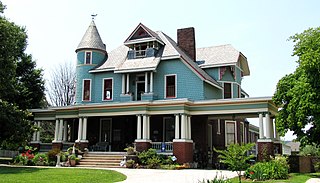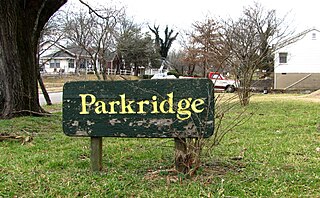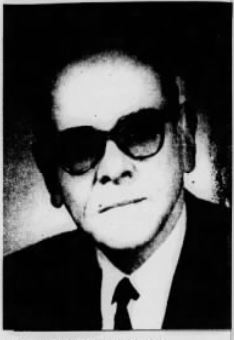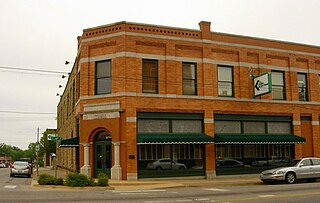Related Research Articles

Okmulgee is a city in, and the county seat of, Okmulgee County, Oklahoma. The name is from the Mvskoke word okimulgee, which means "boiling waters". The site was chosen because of the nearby rivers and springs. Okmulgee is 38 miles south of Tulsa and 13 miles north of Henryetta via US-75. Okmulgee is part of the Tulsa Metropolitan Area.

Cannondale Historic District is a historic district in the Cannondale section in the north-central area of the town of Wilton, Connecticut. The district includes 58 contributing buildings, one other contributing structure, one contributing site, and 3 contributing objects, over a 202 acres (82 ha). About half of the buildings are along Danbury Road and most of the rest are close to the Cannondale train station .The district is significant because it embodies the distinctive architectural and cultural-landscape characteristics of a small commercial center as well as an agricultural community from the early national period through the early 20th century....The historic uses of the properties in the district include virtually the full array of human activity in this region—farming, residential, religious, educational, community groups, small-scale manufacturing, transportation, and even government. The close physical relationship among all these uses, as well as the informal character of the commercial enterprises before the rise of more aggressive techniques to attract consumers, capture some of the texture of life as lived by prior generations. The district is also significant for its collection of architecture and for its historic significance.

The Beaver Hills Historic District is a 97-acre (39 ha) historic district in the Beaver Hills neighborhood of New Haven, Connecticut. It was listed on the National Register of Historic Places in 1986. In 1986, it included 235 contributing buildings.

Old North Knoxville is a neighborhood in Knoxville, Tennessee, United States, located just north of the city's downtown area. Initially established as the town of North Knoxville in 1889, the area was a prominent suburb for Knoxville's upper middle and professional classes until the 1950s. After a period of decline, preservationists began restoring many of the neighborhood's houses in the 1980s. In 1992, over 400 houses and secondary structures in the neighborhood were added to the National Register of Historic Places as the Old North Knoxville Historic District.

Parkridge is a neighborhood in Knoxville, Tennessee, United States, located off Magnolia Avenue east of the city's downtown area. Developed as a streetcar suburb for Knoxville's professional class in the 1890s, the neighborhood was incorporated as the separate city of Park City in 1907, and annexed by Knoxville in 1917. In the early 1900s, the neighborhood provided housing for workers at the nearby Standard Knitting Mill factory.
Requa House is a historic home located at Stuyvesant in Columbia County, New York. It was built in 1904 and is a 2+1⁄2-story Colonial Revival–style dwelling with two porticoed facades. It is set on a slightly graded lot and features a complex roof configuration, with hipped and gable roof sections, gable dormers, and a balustraded widow's walk. Also on the property is a large barn, a smaller brick barn, and a shed.
Cornelius and Agnietje Van Derzee House is a historic home and farm complex located at Coeymans in Albany County, New York. It was built about 1765 and is a rectangular two-story rubblestone dwelling with brick gables. The front facade is five bays with a Greek Revival style central entrance. A craftsman inspired porch was added in 1915. A two-story gable roof wing was added to the south elevation about 1890 and a large, two-story Greek Revival era wing is on the west. It has a moderately pitched gable roof. Also on the property are eleven contributing outbuildings and the agricultural setting. They include a tenant house, large upper barn (1870), hog barn and chicken coop (1813), barn (1825), wagon house (1868), cow barn (1883), wood shop, corn crib, fruit barn (1911), paint house, garage (1890), and brooder house.

William Dubois (1879–1953) was an American architect and politician. He was a prolific architect in Wyoming and nearby states, and served five terms in both houses of the Wyoming Legislature.

The Robison House in Sparks, Nevada, at 409 13th St., is a historic mansion-like house with Colonial Revival elements built c. 1904. The property includes small rental cottages used in Reno, Nevada's "divorce trade". It is listed on the National Register of Historic Places (NRHP).

The Poncan Theatre is a historic theater in Ponca City, Oklahoma. It is individually listed on the National Register of Historic Places, and is a contributing property of the Downtown Ponca City Historic District.
John and Chauncey White House, also known as the John White Homestead, is a historic home and national historic district located near West Sweden, Monroe County, New York. It was built about 1851, and is a 2+1⁄2-story, "L"-shaped, Italianate style brick dwelling with a cross-gable roof. The house was doubled in size about 1880. It features a one-story, full width Colonial Revival porch added about 1900. Also on the property are the contributing barn, stone smokehouse, milk house and ice house, and a garage.

Sibley–Elmdorf Historic District is a national historic district located at Rochester, Monroe County, New York. The district encompasses 840 contributing buildings and 1 contributing site in a predominantly residential section of Rochester. The district developed between about 1904 and 1963, and includes buildings in a variety of architectural styles including Classical Revival, Colonial Revival, Gothic Revival, Tudor Revival, Mission Revival, American Foursquare and Bungalow / American Craftsman. The dwellings reflect designs directed toward a middle-class clientele in a newly developing area of Rochester's Nineteenth Ward. Located in the district is the Westminster Presbyterian Church, West High School by Rochester architect J. Foster Warner, Walter Spencer Public School #16, and Aberdeen Square Park.

Heritage Hills is a historic neighborhood near downtown Oklahoma City. It is known for its historic homes and mansions, some of which are the largest in the city, and the annual Heritage Hills Historic Homes and Gardens Tour. The area is home to Henry Overholser's Overholser Mansion as well as the Hales Mansion. Heritage Hills is bordered by Mesta Park to the west and north, Heritage Hills East to the east, and Midtown to the south.

The Foley Downtown Historic District, in Foley, Alabama, is a historic district which was listed on the National Register of Historic Places in 2005.

Leon Bishop Senter was an American architect who worked primarily in Oklahoma. Although not formally educated in architecture, he became Oklahoma's first licensed architect in 1925 and designed several buildings on the National Register of Historic Places.

Historic Hotels of America is a program of the National Trust for Historic Preservation that was founded in 1989 with 32 charter members; the program accepts nominations and identifies hotels that have maintained their authenticity, sense of place, and architectural integrity. In 2015, the program included over 260 members in 44 states, including the District of Columbia, Puerto Rico, and the U.S. Virgin Islands. In 2022, the program includes 273 hotels. This article lists current and former member hotels.

The Okmulgee Downtown Historic District is the original downtown area of Okmulgee, Oklahoma, roughly bounded by 4th Street, 8th Street, Okmulgee Avenue, and the Frisco tracks. It was added to the National Register of Historic Places on December 17, 1992.

The Okmulgee Public Library located at 218 S. Okmulgee Avenue in Okmulgee, Oklahoma is a functioning public library built in 1921, and listed on the National Register of Historic Places on July 28, 1983.

Built between 1904 and 1907, the Severs Block at 101 E. 6th St. in Okmulgee, Oklahoma is a two-story generally rectangular brick building which incorporates an earlier two-story stone building. The 1882 F.B. Severs’ General Store was a Romanesque structure, the second stone building in all of Okmulgee and the first two-story stone building. Frederick Severs himself expanded his building with the new construction that included storefronts and office space. The canted corner entrance faces the Creek National Capitol. The building was rehabilitated in 1989; that renovation reversed extensive remodeling efforts made in 1954, reconstructed the entry from historical photographs, and generally returned the building to its appearance at the time of its construction.
References
- 1 2 3 4 5 6 7 8 9 "National Register of Historic Places Registration Form, Kennedy Mansion". National Park Service. Retrieved January 31, 2022.
- ↑ "National Register of Historic Places Registration Form, Okmulgee Downtown Historic District". National Park Service. Retrieved January 31, 2022.
- ↑ "Architectural/Historical Survey of Portions of The City of Okmulgee, Oklahoma, p.65". Mary Jane Ward, August 1993 (accessed on Oklahoma Digital Prairie). Retrieved January 26, 2022.
- ↑ "502 S. Okmulgee Ave, Okmulgee, OK 74447". Zillow. Retrieved February 1, 2022.